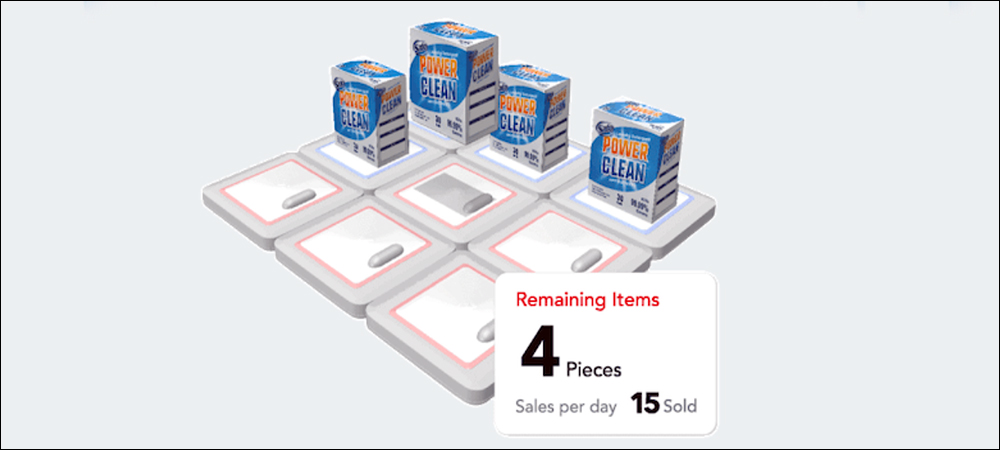RFID Journal LIVE! 2023 will feature end-user companies discussing RFID’s use in retail, as well as exhibitors offering tagging solutions for that industry. To learn more, visit the event’s website.
- Real-Time Tracking for Brands, Retailers
- How the Technology Is Used
- Bringing Visibility to Merchandisers
SATO has released its Dynamic Inventory Replenishment solution, aimed at providing real-time, on-shelf inventory data to retailers and brands, following testing at a Japanese convenience store. The solution consists of a customized, wireless and battery-free IoT Sensing Mat from SATO, with ambient Internet of Things (IoT) company Wiliot‘s IoT Pixel tags using built-in Bluetooth Low Energy (BLE) technology. Energous‘s WattUp PowerBridge node transmits one watt of power, while receiving BLE data from the mats, indicating what is stocked at that location.
The collected data is managed by SATO software on a cloud-based server, and the technology is currently being piloted by a discount retailer in Japan. Companies targeted for the solution include retailers and consumer product brands whose products are stocked on the shelves being monitored. Data can be easily shared with both brands and stores, according to Kerry Langley, SATO’s VP for South America, to help them determine when or where within a store the items sell best.
Real-Time Tracking for Brands, Retailers
There are two key use cases: simply managing goods stacked on store shelves to ensure they don’t need restocking, and monitoring the status of temporary displays of a brand’s products in a highly trafficked and high-valued space, such as at the end of an aisle. In the latter case, brands often want to closely monitor how products are received by customers, as well as ensure that shelves never stand empty.

Kerry Langley
In either scenario, shelf stock levels are traditionally monitored by store personnel or merchandisers who physically look at the shelves and either count products or determine the amount of empty space on a shelf, then provide the necessary restocking. This could be an expensive and labor-intensive process when carried out by workers multiple times per day, or conducted by brand merchandisers who must visit the store regularly.
Some companies have turned to technology to resolve this challenge, such as camera-based systems. However, artificial intelligence (AI) camera-type solutions can be expensive to set up, camera equipment can be costly, and cameras do not necessarily see empty space on shelves that could be behind other products. Additionally, camera-based systems send large packets of data to a server, requiring a network that could accommodate that information.
RFID systems would typically require a tag on each product, as well as the installation of fixed RFID readers or the use of handheld readers. There are several other distinctions between a passive RFID system and Wiliot’s BLE-based technology, says Steve Statler, Wiliot’s chief marketing officer. The company’s IoT Pixel radios are active and able to harvest lower-strength radio signals over time, he explains, then transmit a stronger signal than what was received at any given time with passive RFID.
By avoiding the need for powerful radios, and by using commodity Bluetooth devices, companies can reduce infrastructure costs. Because RFID readers are more expensive, Statler notes, they tend to be handheld and few in number. Bluetooth readers, on the other hand, “can be more pervasive and can constantly communicate,” he states, “meaning that even in challenging situations, readers can be constantly listening for seconds [or] minutes to detect updates.”
How the Technology Is Used
SATO’s IoT Sensing Mat, designed to sit underneath products on a shelf, can be customized to accommodate the size and number of product that will be displayed on it. It comes in sizes as small as a smartphone, and it could be scaled up to the span of a large shelf. Products ranging from small beverage containers to paper towel packages can be monitored. Each product sits on a dedicated space on the mat, which includes a pressure point along with the IoT Pixel tag.

Steve Statler
An Energous Wattup PowerBridge can be installed above or behind shelving in such a way that it remains non-visible but can send and receive energy to and from the mat tags. When a product is placed on a dedicated space on the matt, the pressure point blocks the IoT Pixel tag from receiving an RF transmission from the PowerBridge. Thus, it does not transmit data. If a shopper picks up a product from the mat, the pressure point is released and that action enables the tag to receive the transmission. This provides power that it can harvest, allowing it to transmit back its unique ID number.
The PowerBridge then sends that data to Wiliot’s cloud software wirelessly. The data is interpretted and forwarded to SATO’s cloud-based software, which identifes the location where a product has been removed, based on the tag ID number, and thus determines that a particular space on a shelf is empty. Each time consumers remove products from the shelf, Langley says, “The software updates the inventory data to show a near-real-time count of remaining products.” That information can then be pushed to a retailer’s onsite employees as work instructions.
Workers can view a list of empty shelf spaces, as well as the products that should be stocked there. In that way, onsite personnel can respond to stocking demands as they occur, rather than having to physically check the shelves and count inventory periodically. The result, Langley says, is lower labor costs, an automated way to ensure product availability is maintained, and minimal lost sales, thereby improving revenue and customer satisfaction.
The technology also provides analytics. Retailers could view a dashboard indicating trends, listing how often specific products are selected by customers, when this occurs and at which sites. In that way, Langley explains, “You would be able to make some assumptions about what’s happening at the shelf edge without physically needing to be there.”
Bringing Visibility to Merchandisers
Brands are poised to benefit from the system as well. The technology can provide them with a view into the remote locations where they sell goods in high-value displays that must be monitored. Traditionally, such companies pay employees to visit each store and ensure their product is fully stocked at that location, within the high-traffic areas dedicated to them.
For instance, if a brand launches a new product that could appear at the end of every aisle in specified retail stores, it may reserve this expensive space to draw the attention of shoppers. It could purchase the mats to deploy at each customer site, and install a single WattUp device within range of the shelves. The collected data would enable the company to send an employee onsite to restock, as well as spare that worker from an unnecessary visit if the shelf was still well-stocked.
The mats can be customized according to the needs of a particular retailer or brand, Langley says, though they could be reused with different products if the form factor matched the mat layout. “The mat can be engineered to fit the size of the product that goes on it,” Langley explains. Since the company released the results of the Japanese pilots, she reports, there has been a lot of interest and engagement from retailers, “because instead of having to send their staff out to find where the gaps are in the shelves, and figure out what needs to be restocked, they can simply look at the dashboard.”
According to the company, the mats can be deployed on standard shelves at supermarkets or convenience stores, as well as in coolers. They can also operate in vending-style machines that use stackers of product by which one item is purchased from a machine, and the next available item then drops into its space in the stacker. A mat could be placed at the base of that stacker, transmitting data only if it detects that the stacker is empty.
When it comes to the BLE tags that enable transmission of stock-level data, Statler says, “Being low-cost, small and battery-free, Wiliot’s ambient IoT Pixels are a good fit for the SATO replenishment solution.” He adds, “Because they are Bluetooth, the infrastructure components surrounding them can be low-cost, too.”
Throughout the past year, SATO has worked with the Japanese retailer on a commercial pilot to prove the technology’s effectiveness. The company has been able to use the data from its stores to track various types of shelves with different types of product, and the pilot found that the technology performed very well. Users would purchase the mats and pay a monthly subscription for the data. SATO is focusing on selling the solution in the North American market, as well as in Europe this year.
Key Takeaways:
- Following early testing and deployment at Japanese stores, SATO’s Dynamic Inventory Replenishment solution is now being offered in North America and Europe.
- The solution consists of SATO’s battery-free, wireless shelf mats, with built-in Wiliot IoT Pixel tags tthat transmit shelving status updates with power from Energous transmitters and receivers.


